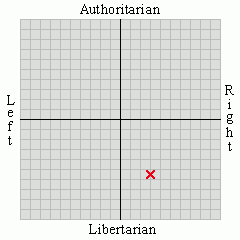Google Earth users have long known this. The 109th Meridian (representing exactly 109° west of the Royal Observatory in Greenwich, England) was set by Congress as the boundary between Colorado and Utah and the boundary between Arizona and New Mexico. So too have confluence enthusiasts chronicled since at least 2001 that the 109th Meridian is about two and a half miles east of the monument so celebrated by travelers that allegedly marks its location. At this latitude, the error is about two minutes and forty-five seconds of longitude. When I draw a line from the center of the monument to the exact point of the confluence on Google Earth, I get exactly 2.5 miles (13,185.65 feet) at a heading of 88.38 degrees. The point of the confluence is shown on Google Earth to be undeveloped alluvial land on the other side of the San Juan River from the monument, and it appears to match the narrative in the link from the confluence-chaser.
Google Earth users going to the Four Corners and zooming in closely to the monument will also notice a diagonal jog in the Utah-Colorado border just north of the monument, and another, longer diagonal jog in the border at about 38° 10' north. In other words, on Google Earth, Colorado is not a perfect rectangle, which is what is described in the laws and therefore what is reality. Google Earth fudges here and there to make its photographic maps fit in to what it usually depicts as flat but must also map onto a sphere, causing projection errors.
And it is the point of confluence, where the 109th Meridian intersects the 37th Parallel, that is the actual spot of Four Corners. If you look up the boundary lines of these various states, you see that Colorado defines its boundaries as follows:
Commencing on the thirtyseventh parallel of north latitude, where the twentyfifth meridian of longitude west from Washington crosses the same; thence north, on said meridian, to the fortyfirst parallel of north latitude; thence along said parallel, west, to the thirtysecond meridian of longitude west from Washington; thence south, on said meridian, to the thirtyseventh parallel of north latitude; thence along said thirtyseventh parallel of north latitude to the place of beginning.Similarly, Utah's boundaries are:
Beginning at a point formed by the intersection of the thirty-second degree of longitude west from Washington, with the thirty-seventh degree of north latitude; thence due west along said thirty-seventh degree of north latitude to the intersection of the same with the thirty-seventh degree of longitude west from Washington; thence due north along said thirty-seventh degree of west longitude to the intersection of the same with the forty-second degree of north latitude; thence due east along said forty-second degree of north latitude to the intersection of the same with the thirty-fourth degree of longitude west from Washington; thence due south along said thirty-fourth degree of west longitude to the intersection of the same with the forty-first degree of north latitude; thence due east along said forty-first degree of north latitude to the intersection of the same with the thirty-second degree of longitude west from Washington; thence due south along said thirty-second degree of west longitude to the place of beginning.This is all fine for many purposes but not for the accuracy demanded in land surveying. Washington, D.C. is not determinate because Washington, D.C. is not a point but rather an area, which is about eight to nine miles from east to west at its wider portions.* So we need to fix a point within Washington to serve as the official meridian point, and since the organic laws establishing and admitting these states was an Act of Congress, it makes sense to fix that point at the Capitol, whose central north-south axis is located at 77° 0' 32.6" west of the Royal Observatory according to my use of Google Earth. That would move the border 32.6" west, which is a distance, at the Capitol's latitude, of just under 3,000 feet.
If it were exactly 77°, that would make the boundary exactly the 109th Meridian. And maybe it is, because there are some overlay problems in Google Earth. But either way, the monument at what is called "Four Corners" is south and west of the confluence point, and south and west of a point located 32.6" west of that confluence point (which would be about two-thirds of a mile off) that would be the right place if the Washington Meridian running through the Capitol is correctly set at 32.6" off of the 77th Meridian. So it's too far to the west, by either two and a half miles or just over 3,000 feet.
Also, none of this solves the fact that the monument is located about 350 feet south of the 37th Parallel.
So the whole thing is in Arizona. And it's also on an Indian reservation. So that makes regulation easy. But it also means the vendors who are operating the site have been selling a lie. The real Four Corners, located at the real confluence, is an unremarkable, barely-accessible, patch of grazing land across the River, in territory marked as Colorado on most maps.
* The District of Columbia was originally supposed to be a square, ten miles to a side, with the corners on exact north-south and east-west axes. However, during the Civil War, Virginia reclaimed the land it had donated to the District to the west of the Potomac River, which land had been about one-third of the District and which remains part of Virginia to this day.







No comments:
Post a Comment